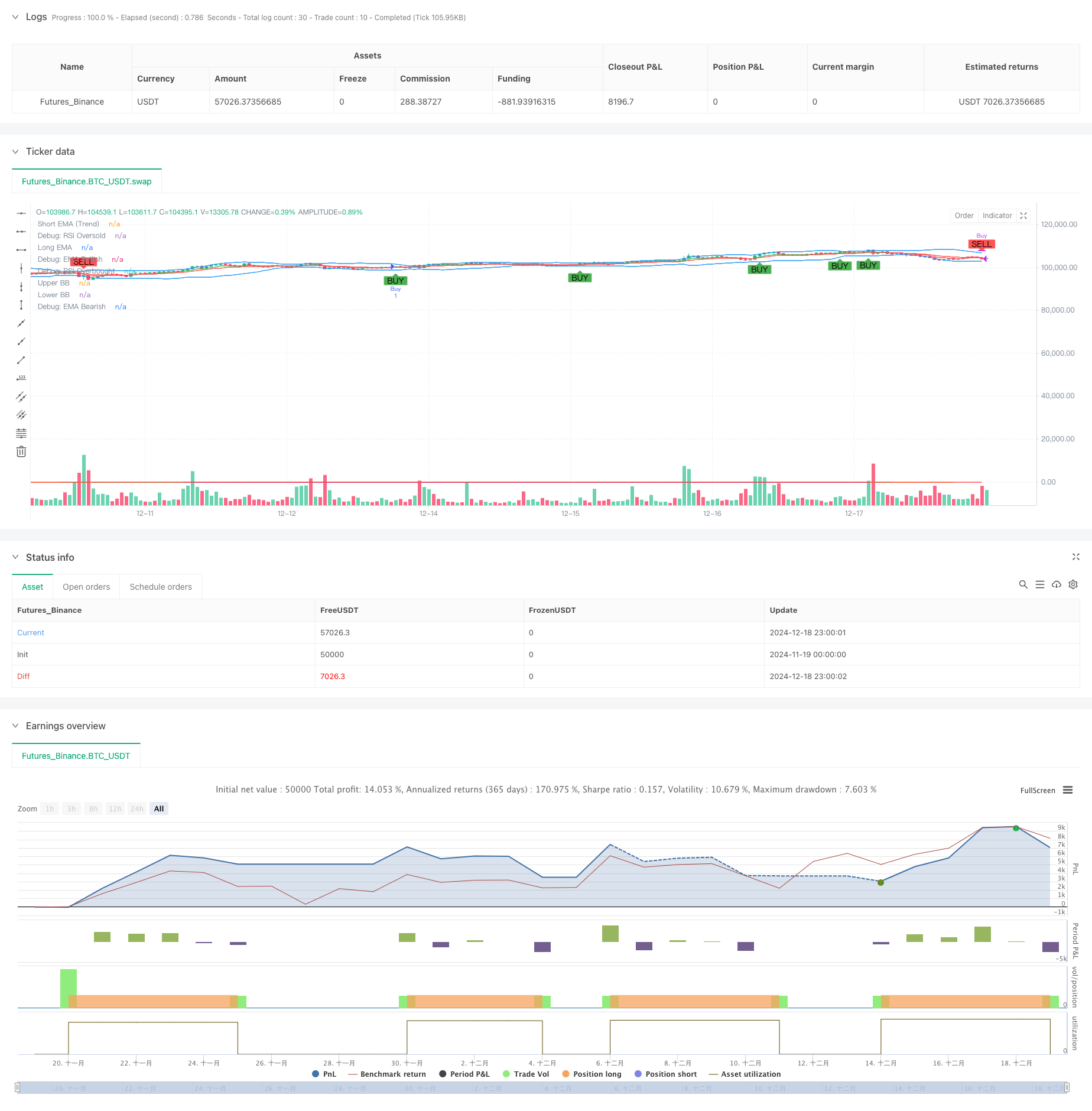
概述
该策略是一个结合了多个技术指标的综合交易系统,主要通过动态监测市场动量和趋势变化来捕捉交易机会。策略整合了均线系统(EMA)、相对强弱指标(RSI)、移动平均收敛散度指标(MACD)、布林带(BB)等多个指标,并引入了基于真实波幅(ATR)的动态止损机制,实现了对市场多维度的分析和风险控制。
策略原理
策略采用多层次信号确认机制,主要包括以下几个方面: 1. 趋势判断:使用7周期和14周期EMA的交叉来确定市场趋势方向 2. 动量分析:通过RSI指标监测市场超买超卖状态,设定了30/70的动态阈值 3. 趋势强度确认:引入ADX指标判断趋势强度,当ADX>25时确认强趋势存在 4. 波动区间判断:运用布林带来界定价格波动区间,结合价格触及布林带情况产生交易信号 5. 成交量验证:使用动态成交量均线过滤,确保交易发生在足够的市场活跃度下 6. 风险控制:基于ATR指标设计的动态止损策略,止损距离为1.5倍ATR
策略优势
- 多维度信号验证,可以有效降低虚假信号
- 动态止损机制提高了策略的风险调适能力
- 结合成交量和趋势强度分析,提高了交易的可靠性
- 指标参数可调,具有良好的适应性
- 完整的进场和出场机制,交易逻辑清晰
- 采用标准技术指标,易于理解和维护
策略风险
- 多重指标可能导致信号滞后
- 参数优化可能存在过拟合风险
- 在横盘市场可能产生频繁交易
- 复杂的信号系统可能增加计算负担
- 需要较大的样本量来验证策略有效性
策略优化方向
- 引入市场波动率自适应机制,动态调整指标参数
- 增加时间过滤器,避免在不利时段交易
- 优化止盈策略,可考虑采用移动止盈
- 加入交易成本考虑,优化开平仓条件
- 引入位置管理机制,实现仓位动态调整
总结
该策略通过多指标协同配合,构建了一个较为完整的交易系统。核心优势在于多维度的信号确认机制和动态的风险控制系统,但也需要注意参数优化和市场适应性问题。通过持续优化和调整,该策略有望在不同市场环境下保持稳定的表现。
策略源码
/*backtest
start: 2024-11-19 00:00:00
end: 2024-12-19 00:00:00
period: 1h
basePeriod: 1h
exchanges: [{"eid":"Futures_Binance","currency":"BTC_USDT"}]
*/
//@version=5
strategy("XRP/USDT Scalping Strategy", overlay=true)
// Input Parameters
emaShortLength = input.int(7, title="Short EMA Length")
emaLongLength = input.int(14, title="Long EMA Length")
rsiLength = input.int(7, title="RSI Length")
rsiOverbought = input.int(70, title="RSI Overbought Level") // Adjusted to 70 for broader range
rsiOversold = input.int(30, title="RSI Oversold Level") // Adjusted to 30 for broader range
macdFastLength = input.int(12, title="MACD Fast Length")
macdSlowLength = input.int(26, title="MACD Slow Length")
macdSignalLength = input.int(9, title="MACD Signal Length")
bbLength = input.int(20, title="Bollinger Bands Length")
bbStdDev = input.float(2.0, title="Bollinger Bands Standard Deviation") // Adjusted to 2.0 for better signal detection
// EMA Calculation
emaShort = ta.ema(close, emaShortLength)
emaLong = ta.ema(close, emaLongLength)
// RSI Calculation
rsi = ta.rsi(close, rsiLength)
// MACD Calculation
[macdLine, signalLine, _] = ta.macd(close, macdFastLength, macdSlowLength, macdSignalLength)
macdHistogram = macdLine - signalLine
// Bollinger Bands Calculation
basis = ta.sma(close, bbLength)
deviation = ta.stdev(close, bbLength)
bbUpper = basis + (bbStdDev * (deviation > 1e-5 ? deviation : 1e-5)) // Ensure robust Bollinger Band calculation
bbLower = basis - bbStdDev * deviation
// Volume Condition
volCondition = volume > ta.sma(volume, input.int(20, title="Volume SMA Period")) // Dynamic volume filter
// Trend Strength (ADX)
// True Range Calculation
tr = math.max(high - low, math.max(math.abs(high - close[1]), math.abs(low - close[1])))
// Directional Movement
plusDM = high - high[1] > low[1] - low ? math.max(high - high[1], 0) : 0
minusDM = low[1] - low > high - high[1] ? math.max(low[1] - low, 0) : 0
// Smooth Moving Averages
atr_custom = ta.rma(tr, 14)
plusDI = 100 * ta.rma(plusDM, 14) / atr_custom // Correct reference to atr_custom
minusDI = 100 * ta.rma(minusDM, 14) / atr_custom // Correct reference to atr_custom
// ADX Calculation
adx = plusDI + minusDI > 0 ? 100 * ta.rma(math.abs(plusDI - minusDI) / (plusDI + minusDI), 14) : na // Simplified ternary logic for ADX calculation // Prevent division by zero // Prevent division by zero // Final ADX
strongTrend = adx > 25
// Conditions for Buy Signal
emaBullish = emaShort > emaLong
rsiOversoldCondition = rsi < rsiOversold
macdBullishCrossover = ta.crossover(macdLine, signalLine)
priceAtLowerBB = close <= bbLower
buySignal = emaBullish and (rsiOversoldCondition or macdBullishCrossover or priceAtLowerBB) // Relaxed conditions by removing volCondition and strongTrend
// Conditions for Sell Signal
emaBearish = emaShort < emaLong
rsiOverboughtCondition = rsi > rsiOverbought
macdBearishCrossover = ta.crossunder(macdLine, signalLine)
priceAtUpperBB = close >= bbUpper
sellSignal = emaBearish and (rsiOverboughtCondition or macdBearishCrossover or priceAtUpperBB) // Relaxed conditions by removing volCondition and strongTrend
// Plot EMA Lines
trendColor = emaShort > emaLong ? color.green : color.red
plot(emaShort, color=trendColor, title="Short EMA (Trend)") // Simplified color logic
plot(emaLong, color=color.red, title="Long EMA")
// Plot Bollinger Bands
plot(bbUpper, color=color.blue, title="Upper BB")
plot(bbLower, color=color.blue, title="Lower BB")
// Plot Buy and Sell Signals
plot(emaBullish ? 1 : na, color=color.green, linewidth=1, title="Debug: EMA Bullish")
plot(emaBearish ? 1 : na, color=color.red, linewidth=1, title="Debug: EMA Bearish")
plot(rsiOversoldCondition ? 1 : na, color=color.orange, linewidth=1, title="Debug: RSI Oversold")
plot(rsiOverboughtCondition ? 1 : na, color=color.purple, linewidth=1, title="Debug: RSI Overbought")
plotshape(series=buySignal, title="Buy Signal", location=location.belowbar, color=color.green, style=shape.labelup, text="BUY")
plotshape(series=sellSignal, title="Sell Signal", location=location.abovebar, color=color.red, style=shape.labeldown, text="SELL", size=size.small) // Dynamic size for signals
// Strategy Execution with ATR-based Stop Loss and Take Profit
// Reuse atr_custom from earlier calculation
stopLoss = low - (input.float(1.5, title="Stop Loss Multiplier") * atr_custom) // Consider dynamic adjustment based on market conditions // Adjustable stop-loss multiplier
takeProfit = close + (2 * atr_custom)
if (buySignal)
strategy.entry("Buy", strategy.long, stop=stopLoss) // Removed limit to simplify trade execution
if (sellSignal)
strategy.close("Buy")
相关推荐